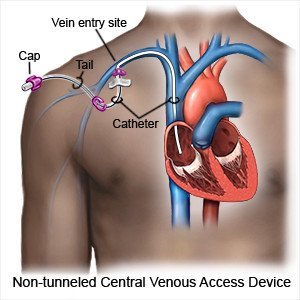Non-Tunneled Central Lines
Medically reviewed by Drugs.com. Last updated on Aug 4, 2025.
WHAT YOU NEED TO KNOW:
A non-tunneled central line is a short-term IV catheter placed into a large vein near your neck, chest, or groin. You will need to flush and care for your central line as directed.
 |
HOW TO PREPARE:
Before your procedure:
- Tell your healthcare provider about all medicines you currently take. He or she will tell you if you need to stop any medicine for the procedure, and when to stop. He or she will tell you which medicines to take or not take on the day of the procedure.
- Tell your healthcare provider if you have a history of problems with blood clotting. Tell healthcare providers if you have had a central line before.
- You may need to have an ultrasound or other tests before having the central line placed.
The day of your procedure:
- You or a close family member will be asked to sign a legal document called a consent form. It gives healthcare providers permission to do the procedure or surgery. It also explains the problems that may happen, and your choices. Make sure all your questions are answered before you sign this form.
- Take only the medicines your healthcare provider told you to take.
- An anesthesiologist will talk to you about medicines to keep you asleep or to numb the area. Tell healthcare providers if you or anyone in your family has had a problem with anesthesia in the past.
- You may be given sedative medicine to help you remain calm and relaxed during the procedure.
WHAT WILL HAPPEN:
What will happen:
- The table may be tipped so that your head is slightly lower than your feet. Your healthcare provider will insert a needle through your skin until the needle reaches your vein. Ultrasound or x-ray may be used to help guide placement of the catheter. The catheter may be placed through your chest, neck, or arm.
- A guide wire will be used to help place the catheter in your vein. A catheter that contains or is coated with germ-killing medicine may be used to help prevent infection.
- The needle and guide wire will be removed, and the catheter will stay in the vein. Healthcare providers will secure the catheter to your skin with tape or stitches. A new bandage will be placed over the area to keep it clean and help prevent infection.
CONTACT YOUR HEALTHCARE PROVIDER IF:
- You have a fever.
- You have questions or concerns about having your catheter put in.
Risks
- The catheter may go into the wrong area or blood vessel during the procedure. Air or blood may get into the space around your lungs, causing heart or lung problems. You may get an infection where the catheter enters your body, or in your bloodstream. The catheter may break, bend, or move out of place, and not work. You may need to have the catheter replaced.
- Medicine may leak on your skin, causing swelling, pain and blisters. You can have bleeding, an allergy to heparin, or heparin-induced thrombocytopenia (HIT). HIT is a low number of blood platelets, which increases the risk of bleeding. You may get a blood clot in the vein where your catheter was placed. This can cause pain and swelling, and it can stop blood from flowing where it needs to go in your body. The blood clot may break loose and travel to your lungs. This can be life-threatening.
Care Agreement
You have the right to help plan your care. Learn about your health condition and how it may be treated. Discuss treatment options with your healthcare providers to decide what care you want to receive. You always have the right to refuse treatment.© Copyright Merative 2025 Information is for End User's use only and may not be sold, redistributed or otherwise used for commercial purposes.
The above information is an educational aid only. It is not intended as medical advice for individual conditions or treatments. Talk to your doctor, nurse or pharmacist before following any medical regimen to see if it is safe and effective for you.
Further information
Always consult your healthcare provider to ensure the information displayed on this page applies to your personal circumstances.
